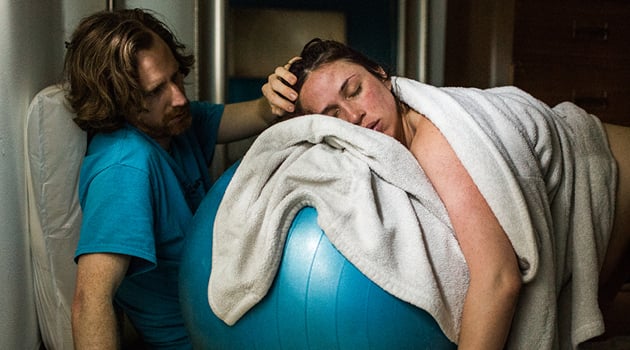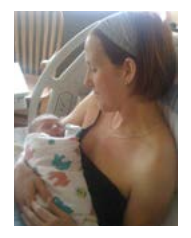Photo above by Danica Donnelly: Holly Palkowitsch of Eagan gave birth to her daughter, Wilhelmina, with her partner, Chris, by her side, as well as two midwives. Read her home birth story at the end of this article.*
Everything you ever wanted to know about having your baby at home (well almost)!
American birth culture has gone through many phases of development in the last century — from the disturbing use of “twilight sleep” for pain management (essentially knocking the mother unconscious) to the epidural as the choice du jour (which allows the birther to be mentally present).
Various levels of intervention have prevailed, with noticeable peaks in both the 1930s — when hospital births first accounted for the majority of births — and the 2000s, when the U.S. C-section rate reached 30 percent. To put this number in perspective, the World Health Organization (WHO) considers the ideal rate to be between 10 and 15 percent.
Right now, birth culture is a mixed bag of choice and intervention. Natural birth and mother-child bonding after birth are generally supported. Though C-sections are life-saving when necessary, elective use of the procedure (scheduling Baby’s birth for convenience) and overuse of interventions (such as labor induction or augmentation with Pitocin) are what push the rate above the WHO recommendation.
As with any major surgery, there are several risks to the mother associated with a Caesarean delivery, including but not limited to blood clots, hemorrhaging and reaction to the anesthesia. Recovery is also more of a process (often three to five days in the hospital) due to the incisions in the abdominal wall and the uterus.
In many ways, now is the very best and the very worst time to give birth. Breastfeeding is supported, doulas are the norm, non-narcotic pain management is available, many hospitals have birthing tubs, and the terms “birth choice” and “birth plan” are now common phrases.
However, the C-section rate isn’t going down. It’s at a whopping 32 percent in the U.S., and rising swiftly internationally to more than 50 percent in some countries. In Minnesota, the rate was 27.4 percent by the CDC’s last count.
Making the choice
While less than a century ago, everyone gave birth at home, today the home-birth rate in the U.S. is less than 2 percent — though between 2004 and 2014 the Minnesota out-of-hospital birth rate (at both homes and birth centers) grew by more than 300 percent.
Though some still think of home birth as alternative or crunchy, it’s steadily becoming a choice that’s accepted, if not mainstream.
There are many reasons a family might choose home birth:
- A desire to birth without medical intervention;
- A desire to give birth in a comfortable, familiar environment;
- Cultural or religious beliefs;
- Unhappiness with or mistrust of hospital care, possibly from a previous birth experience;
- Convenience of cost and/or transportation to a hospital.
Many home-birthing families choose home birth to allow for freedom and control over the birthing experience — and because they believe in the midwifery model of care. Many simply believe that birth is (usually) a non-medical event.
“I was born at home in the ’80s,” said Twin Cities birth photographer Raven Ivory, whose mother is a longtime midwife. “I feel strongly that home birth should be the default, the norm. Birth is a normal, physiological event — that we treat as a medical emergency by default. I often wonder how different our society would be if we all grew up with stories and images of empowered, beautiful, intense-but-not-painful birth.”
Sasha Sobaszkiewicz Griner, a Hastings mother of three, said her home birth was extraordinary.
“It was the most raw, genuine experience I have ever had in my life,” she said. “Nothing compares to it and I was left with a sort of ‘birth high’ for about a week — something I didn’t experience with either of my other children.”
Home-birth myths: Busted
Myth: Midwives are not trained. Midwives are extensively trained and committed to staying up to date on certifications and research.
Myth: Midwives are against hospital birth and therefore unable to recognize situations in which birth would be safer in a hospital setting. Midwives know there’s a time and place for medical intervention and they take that decision-making process seriously.
Myth: Home birth is messy. Home birth supplies include ample pads and coverings and midwives are good at managing mess, leaving without a trace.
Myth: Home birth is expensive and not covered by insurance. Home birth is often less expensive than a traditional birth and is insurance usually covers the majority of the cost.
Myth: Home birth is for hippies. In the 1970s, maybe. Now a variety of families are choosing home birth.
Myth: Home birth isn’t safe. The C-section rates and maternal and infant mortality rates are lower for home birth, making it a safe choice for low-risk pregnancies.

Photo by Twin Cities birth photographer Raven Ivory
The myths, the reality
Home birth is not a wild and crazy ritual that happens in the woods, under the moonlight.
The 98 percent of Americans who choose not to birth at home might ask: Isn’t it dangerous? Isn’t it messy?
Some would argue that home birth, in a low-risk pregnancy, is actually safer than a hospital birth. The reasons are: reduced exposure to infection, reduced rates of intervention and reduced rates of C-section.
Emme Corbeil, a certified professional midwife licensed by the Minnesota Board of Medical Practice, said most home-birth midwives have C-section rates well below 10 percent.
“My Cesarean rate was 5 percent,” she said.
Midwifes, to be clear, don’t actually perform C-sections. C-sections happen in hospitals — and are performed by obstetricians/surgeons. But most midwives keep track of the number of their births that end in C-sections.
What many parents-to-be don’t realize is that home birth is surprisingly more “medical” or at least more procedural than mythology might imply.
During prenatal care, midwives can and do test the mother’s urine, blood and blood pressure — and the baby’s measurements and heart rate. They’re highly trained, certified and continuously recertified, and are adept at recognizing signs of illness, complication or irregularity in pregnant women.
They have a strict board of review and take their licensure seriously. Most recommend hospital birth or emergency transfer sooner rather than later, if needed.
At the home, during labor and birth, midwives carry oxygen, may administer Pitocin for hemorrhage, can provide local anesthesia for sutures and can repair a torn perineum. They can give antibiotics, vitamin K and RhoGAM in cases of Rh issues. Midwives carry and are able to provide IV fluids and can treat an allergic reaction. Everything encountered at a normal, low-risk, natural hospital birth is present at a home birth.
What elevates midwives’ skill set more than this checklist, however, is the fact that they take ample time with each client throughout the pregnancy, so that there’s a foundation of knowledge and familiarity that’s unparalleled.
The midwifery model dictates that each prenatal appointment last an hour, assessing the big-picture health — and therefore candidacy for home birth — of the expectant mother. By the time labor kicks in, the birthing mother has a deeply rooted trust in her care provider, and she won’t have to worry over whether her chosen provider is the one on call at time of birth.
Likewise, the midwife knows her client well and knows when (and when not) to intervene.
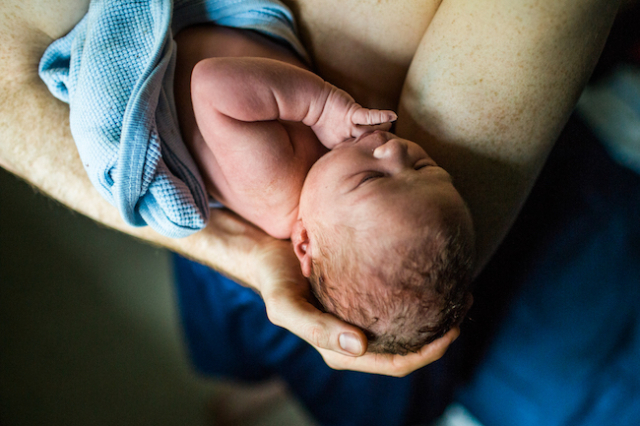
Photo by Danica Donnelly*
Bonding after delivery
Home birth can often have a positive, healthy influence on the postpartum experience. Uninterrupted and literally at home, a mother is free to bond with the baby on her own terms, in her own bed. Danielle Downs Spradin of Oasis Lactation Services in Eden Prairie said there’s a statistically lower incidence of breastfeeding difficulty among home-birthing families.
“While most hospitals in the Twin Cities are supportive of steps to establish breastfeeding early, this isn’t the case in all rural hospitals or in hospitals across the country,” said Spradin, who is an International Board Certified Lactation Consultant and a Certified Lactation Counselor.
Separation immediately after birth to handle non-urgent tasks such as bathing and weighing the baby can interfere with the immediate, instinctive interaction that takes place between mother and baby, which leads to breastfeeding.
Bathing also washes off the amniotic fluid, making the scent part of Baby’s breast crawl more difficult. (To learn more about the natural process that is the breast crawl, go to mnparent.com/golden-hour.)
Well-care nurseries and frequent interruption also mess with the already clumsy dance between the nursing mother and child. IV fluids, pain medication, anesthesia and forceps (which can have a temporary effect on the baby’s facial muscles) can also interfere with breastfeeding success.
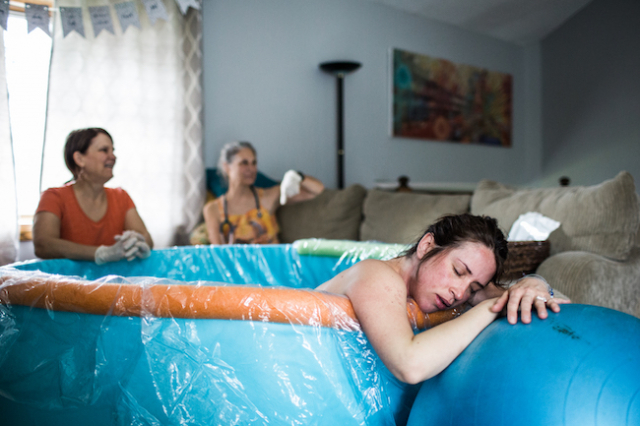
Photo by Danica Donnelly*
Reasons not to home birth
Home birth, Corbeil said, is for “healthy birthing people with a healthy, low-risk pregnancy. Home birth isn’t for everyone.”
Midwives take this philosophy seriously. Most births are “normal” and healthy and the vast majority of people can happily birth at home. Some can’t. And that’s OK.
Home birth isn’t appropriate when:
- Pregnancy complications such as gestational diabetes or severe preeclampsia are present;
- You think you might want pain medications;
- Your baby is at risk — or you feel that he or she might be;
- Home birth is a source of significant contention between the birthing parent and her partner.
Some conditions such as VBAC (vaginal delivery after Caesarean), breech delivery and multiples are up for debate.
Do plenty of research and vet several birth teams and birth locations to find what feels right. Home birth can be a lesser-known path to VBAC when your local hospital has a policy against it.
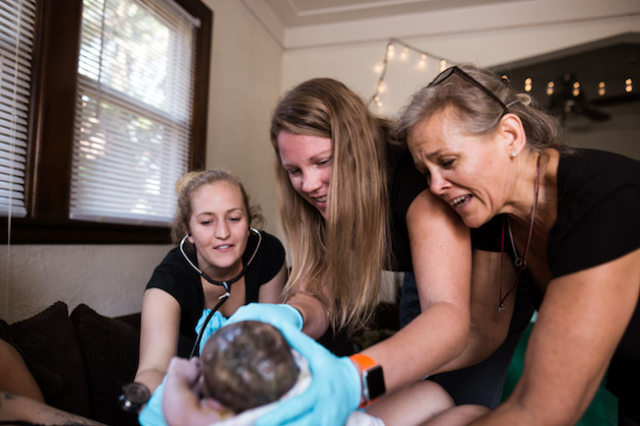
Photo by Twin Cities birth photographer Raven Ivory
WHAT’S A BIRTH CENTER?
Many consider birth centers to be a happy medium between a home birth and hospital birth. They’re known for cozy, cushy birth suites that feel homelike, but also have the exact same capabilities and equipment a midwife typically offers. Some birth centers are close to, attached to — or have acquired privileges at — a hospital, making transfers quick and seamless.
Learn about local birth centers and the pros and cons of other birth options (including hospital births) at mnparent.com/where-to-birth.
When things don’t go as planned
If you’ve considered home birth, but are afraid of “something going wrong” or that you’d have to undergo a hospital transfer, understand this: Transfer is rare. But in a true emergency, midwives are fully capable of holding down the fort until first responders arrive — and midwives tend to make a call long before a full-on emergency is in play.
Upon transfer, you can expect the same excellence of care from your midwife team that you received throughout pregnancy.
Amey Haas of Minneapolis transferred after three days of unproductive contractions and subsequent exhaustion, eventually learning that her baby was both posterior (face up) and asynclitic (head tilted and misaligned with the birth canal).
“Our midwife had our records transferred to the hospital midwife before we even got there,” Haas said. “Our midwife and our doula both stayed until after the baby was born. They helped with every facet of labor.”
Haas said even her “very hospital-preferring wife” has been considering a home birth of her own, despite Haas’ transfer during her home birth.
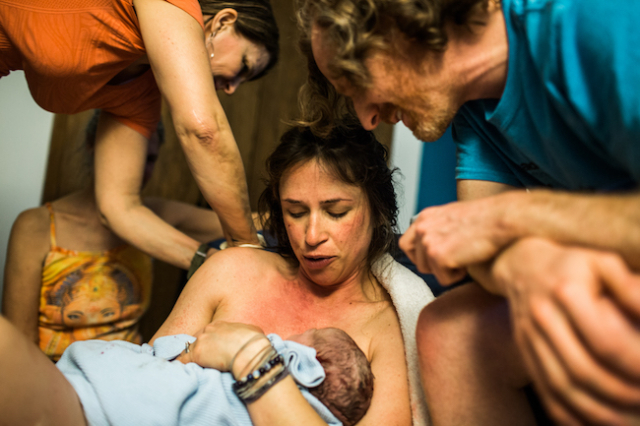
Photo by Danica Donnelly*
The problem with fear
Home birth can be an amazing and empowering experience for those who want it. It is not the “better” choice. It is not the “right” choice. It is a choice that feels right to some expectant parents.
“Perhaps the greatest influence on a person’s birth journey is the presence or absence of fear,” Ivory said. “Fear has the ability to intensify all sensations, the ability to shut down labor. Think of a giraffe in labor on the savanna. If a lion approaches, the baby doesn’t just fall out. The introduction of fear is great enough to cease labor long enough for the giraffe to escape. For me, birthing where I felt safest was my main priority. And I felt safest at home, surrounded by the things and people I love, in my own clothes, with the ability to move and eat as I needed.”
Learn more!
To read a personal account of a home birth (after a pervious hospital birth), check out the Bump, Birth and Baby column at mnparent.com/bump-birth-baby.
MCCPM: For a directory of local midwife services and home-birth friendly providers, check out the Minnesota Council of Certified Professional Midwives at mccpm.org.
Evidence Based Birth: This online childbirth resource at evidencebasedbirth.com, informs expecting parents and birth-care practitioners on the latest evidence-based care practices.
Tell your story: Jaime Fleres’ new book, Birth Your Story, encourages parents to remember, process and honor their birth experiences through writing. Learn more at jaimefleres.com.
Jen Wittes is a marketing director, writer, certified postpartum doula and mom of two living in St. Paul.
*Holly Palkowitsch of Eagan tells the story of her home birth: My birth with Wilhelmina was hard. It was intense. There came a point when I truly did not feel like I could do it. I voiced it out loud to my birth team and I cried. Then…it happened. I surrendered. I let go of everything — all thoughts, all fears, all of the intensity. I let it all go. It was at that point, I stood up, walked into a small, dark corner of my bedroom, gathered all the strength I had and like a roaring animal on all fours, I birthed my baby into my arms.






